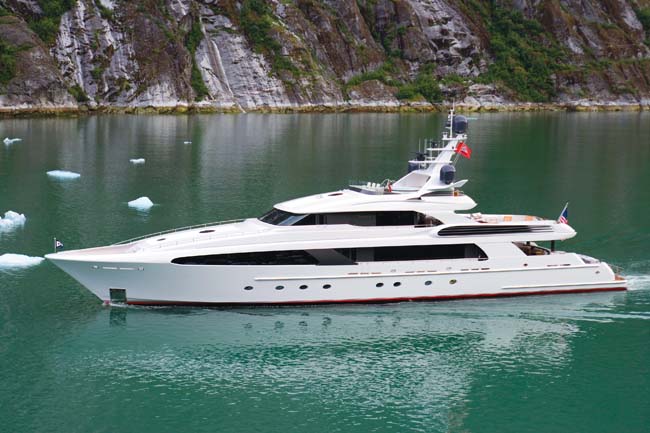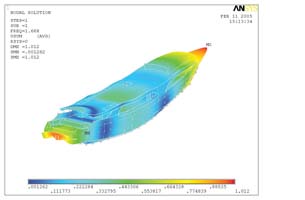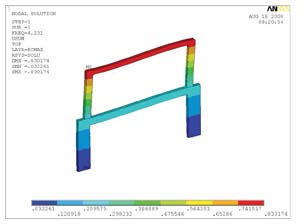Fast App: ANSYS Mechanical Solves Challenges of a Megayacht Builder
The conflicting demands of interior design aesthetics and top-notch structural characteristics are resolved with the use of finite element analysis.
Latest News
October 21, 2009
By DE Editors
Delta Marine, based in Seattle, WA, earned its reputation as a highly successful builder of commercial fishing vessels, primarily for use in Alaska, notorious for its harsh conditions. In the 1980s, Delta shifted its focus and embarked on the mission of becoming an industry leader in the luxury yacht market. Delta has since accomplished this, and the company has received top awards in several categories, including “Best Motor Yacht Interior” and “Highest Technical Achievement” at the elite annual ShowBoats Rendezvous in Monaco.
 Figure 1. Mr. Terrible, cruising in Alaskan waters (Photo by Neil Rabinowitz) |
Delta uses finite element analysis software to design the composite structural members of its boats to provide strength and minimize vibration while maintaining weight targets. The result is a series of stunning and noteworthy megayachts, such as Mr. Terrible, launched in 2007 (Figure 1), with an open floor plan and attractive styling. The 154 ft., semi-displacement design is built for high performance, reaching maximum speeds of 24 knots, even though it uses heavyweight wenge, buginga, and koa woods (creating a Polynesian look).
Professional Mariner magazine made the following comments about Mr. Terrible: “What is most impressive about the execution of the interior is the almost overwhelming amount of detail. The flawless application of complex shapes of contrasting wood or polished stainless steel applied to wood-clad columns, built-in furniture pieces, or overhead panels is stunning.” The extra weight and nonstandard pillar placement dictated by this striking interior created major composite design challenges in Mr. Terrible. These complexities were duplicated in the design of Delta Marine’s newest 156 ft. long megayacht, which has a composite hull and superstructure and will be certified by Lloyd’s Register for unrestricted ocean operation.
 Figure 2. Mr. Terrible‘s hull first mode of vibration (Courtesy of ANSYS) |
Graphite Composite Design
“Graphite composites provide the ideal material for megayacht design because they are stiffer and stronger than metals per unit of weight, making it possible to build a lighter and stronger boat,” says Chad Caron, P.E., naval architect for Delta. “Composites enable more flexible designs because their physical properties can be tailored to a very high degree.” Caron adds that, in the past, interior design was constrained by structural considerations; more recently, advancements in composites have provided designers with far more flexibility. For example, the location of pillars today can be more readily accommodated by the structural engineers to suit the interior designers’ vision for an overall successful collaboration.
“It’s a rare boat now that has the pillars aligned,” says Caron. “These days, a pillar is as likely as not to land in the middle of a beam. When pillars are not aligned, it becomes much more difficult to determine how loads will distribute among the various structural elements. Traditional design methods, such as handbook formulas and rules of thumb, are not adequate to achieve an optimized structural assessment. The load path becomes convoluted with many 90° angle turns that require taking the exact geometry and load locations into account. This means that analysis typically needs to be performed on a global basis, which in turn requires very powerful software and hardware.”
 Figure 3. Delta’s latest project has a racking frame, shown here resisting a roll acceleration (Courtesy of ANSYS) |
The horizontal structural elements in a megayacht are the decks. In Delta’s latest megayacht, the decks (from top to bottom: flybridge, boat deck, and weather deck) are made of 2 in. thick composite sandwich construction. The vertical structural elements consist of freestanding pillars, used to support beams and vertical beams attached to the superstructure plating, the mullions. To fulfill the client’s request for side-launching tenders, Delta developed 21 in. deep, 1 in. thick carbon-fiber channel sections to support the crane.
Optimizing Weight Management
Caron says the company selected ANSYS Mechanical technology as its structural design software seven years ago because its composite-analysis capabilities were well ahead of that of its competitors. “In particular, at the time we made our selection, ANSYS Mechanical was the only finite element software we could find with a composite shell element,” says Caron. The engineer adds that other software packages have made advances since the initial selection, but he feels that the ANSYS Mechanical package has maintained its advantage in composite-design capabilities. ANSYS offers complete composites solutions for modeling layered shells and solids. It includes generalized section definitions for layer properties, orientation, and failure and cohesive zone materials modes for studying delaminations in composites.
Delta naval architects model the major shapes of a yacht in Rhino 3D and develop the shop drawings in AutoCAD. The Rhino 3D model is exported to a neutral file format and imported into ANSYS Mechanical to provide the geometry for the model. Caron uses composite shell elements to model the laminate stack layer by layer. He uses solid elements for foundation parts cast in resin and in scantlings that have structurally significant core.
The prediction of vessel vibration frequencies depends on the total weight distribution for the yacht (Figure 2). The interior design can increase overall weight through substantial use of hardwood and stone, so common in today’s yachts (especially for megayachts that incorporate heavyweight trimmings). Delta has developed parametric approaches to estimate interior weights, using targets on a per-square-foot basis for various materials. The outfit weight, along with the other structural and mechanical weight components, coupled with the hydrodynamic added mass of the water, directly affect the vibration frequencies and mode shapes the yacht will exhibit. Accurately predicting these frequencies and mode shapes are critical to successful design.
Designing for Strength
Caron designed the company’s newest megayacht in two stages: first for strength and then to resist vibration. Today’s yacht buyers are interested in a luxurious interior and a high cruising speed, but behind the scenes, designers know it is critical to optimize the structural elements to deliver the required strength while avoiding any extra weight that would reduce the speed of the boat. Caron used ANSYS Mechanical technology to evaluate global and local stresses on a layer-by-layer basis. Most other finite element analysis packages merely average the loads over the stack.
“ANSYS Mechanical tells us exactly where the load is going, down to the individual composite layer,” says Caron. “This simplifies the design of the mullions, beams, and pillars.” The ability to distribute the loads among the different layers also helps to tune the laminate stack. Delta uses ANSYS reports to detail and defend structural decisions that the regulatory body rule books cannot cover adequately.”
Designing to Resist Vibration
Even after a structure has been designed to support the design loads, the yacht can still vibrate. Caron performed modal analysis on the same ANSYS Mechanical model to investigate its primary modes of vibration. The technology determines the natural frequencies of the mass matrix. Analysis results showed that the first mode of vibration was a racking mode, which means that the superstructure of the boat vibrated horizontally, with the decks decoupling from each other like a deck of cards sliding back and forth.
The engineer addressed the concern by adding a racking frame, a structure that spans two decks and resists horizontal motion (Figure 3). The racking frame consists of a box 17 ft. tall, 7 in. wide, and 8–17 in. deep, made of ½ to 1inch thick carbon fiber. “I modeled the racking frame using 0/90 and +45/–45 biaxial laminate and unidirectional carbon fiber,” says Caron. “The finite element analysis results identified the stresses on the structure and helped determine which layer buildup should be used on each particular part of the frame.” Caron also was concerned about the longitudinal second mode of vibration identified in the modal analysis. This mode generated a high bending moment near the middle of the ship. He addressed that mode by strengthening the hull and decks to make them stiffer in the area that experiences the highest bending moment.
Benefits
“ANSYS Mechanical finite element analysis helps us create a more beautiful, stronger, and faster megayacht design,” concludes Caron. “Finite element analysis makes it possible to determine exactly how loads distribute through the complex structure, so we can tailor the properties of structural elements to provide strength and stiffness exactly where it is needed. These capabilities free the designers to put walls and partitions wherever they want and keep the weight to a minimum. As a result, the new boat delivers the optimal combination of luxury and performance.”
Subscribe to our FREE magazine, FREE email newsletters or both!
Latest News
About the Author
DE’s editors contribute news and new product announcements to Digital Engineering.
Press releases may be sent to them via [email protected].






